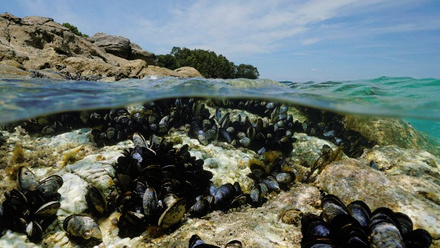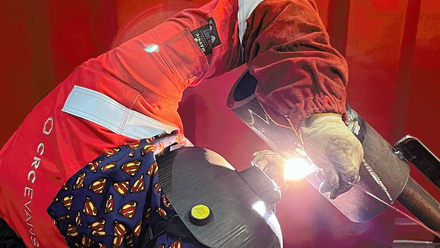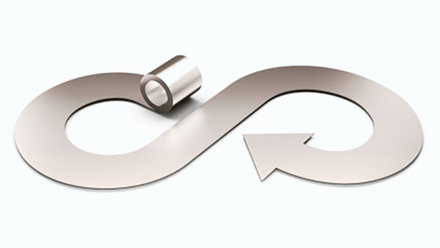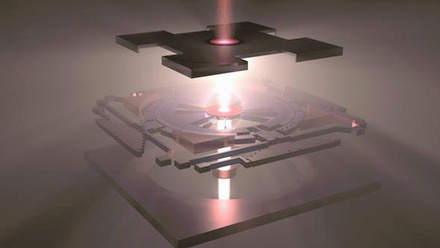The science of steel
This section introduces some of the key factors affecting the properties of steel including the atomic interactions affecting steel properties.

Introduction to Steel
In very simple terms, iron in its solid form assumes a crystalline structure. This means that iron atoms are arranged in a regular repeating pattern called a lattice.
Steel is an alloy of carbon and iron. The video further explains what steel is, and the effect of carbon on steel.
It is important to recognise that carbon (and nitrogen) can enter the crystal structure in the spaces between the iron atoms as they have a very small atomic size. These are called interstitial elements of steel. below is an example of a body centre cubic unit cell and is the crystalline form of pure iron.
Impact of alloying elements
Whilst sulphur and phosphorous are usually removed from steels due to their impact on mechanical properties during the desulphurisation and oxygen blowing stages of the process, they can be finely controlled to provide desirable properties for engineering steels to produce a free cutting characteristic and to increase the strength and weathering performance of some strip steels.
Another important element, investigated by Irvine, Pickering and Gladman, is niobium.
This is used to increase strength and toughness in combination with specific rolling techniques, vanadium is used for similar purpose in the United States. These elements restrain grain boundaries giving improved toughness and the internal strength of the grains is strengthened by very fine precipitation.
Typical types of steels
Depending upon the processing route, many different grades of steels can be created. These can have impacts on the microstructures, hardenability and subsequent uses. The video below touches on some of the impacts that the processing can have due to cooling.
These different types of steels can be etched with a variety of acids to show the grain structure and other phases in the steel. Some of which can be spectacular.
Very low carbon steels
These types of steels are normally very ductile, they are easy to press.
Examples of applications for very low carbon steels include car bodies, white goods and steel cans. Steel cans and automotive bodies are very demanding products requiring tight control on alloying elements to enable their demanding forming methods.
Low carbon steels
When the carbon level increases, strength increases however ductility decreases. This higher strength and thicker steel is used in the wheel and banding steel markets. Aluminium is being used to directly compete with the automotive wheel market.
Marine steels
Further increases in carbon, alongside increases in manganese and niobium. Marine steels are very demanding, with very high strength steels required for the armour plating.
Cargo ships are less demanding than warships, such as the Type-45 destroyer developed by the UK, however lightweighting is being looked into using more alloyed steels to reduce the overall weight and thus carbon footprint of the vessels. The cruise ship market is highly competetive, with aluminium also being used as a competitor for alloyed steels for lightweighting. New grades of steels are constantly being developed to improve the cost/weight performance to meet customer requirements.
Steels for the chemical industry
Depending upon the role of the steel, very different elements will be used to meet the customer requirement.
Pressure vessels for high temperature applications, for example, require chromium and molybdenum additions to impart the desired strength and cooling temperature requirements.
Construction steels
In the construction industry, wear and abrasion resistance are commonly required. This tends to lead to usage of chromium, titanium, molybdenum and boron. However, in different ratios than other types of steel mentioned previously.
Rail steels
There are many different types of rail steels, this is due to the volume of potential applications. These include, but are not limited to:
- Underground railway lines (London Underground)
- Tram tracks, as in some UK cities, such as Sheffield and Birmingham, and Continental Europe
- High speed rail tracks (UK/Europe)
- Slow speed rail tracks (USA)
- Curved railway tracks
These will be discussed further in the Steel in transport guide. However, they have a multitude of abrasion performance, formability and environmental conditions, such as coastal and temperature) which all add to the challenge.
Stainless steels
Stainless steels are a broad family of chromium rich steels. There are many different groups within it, however the two major types are StainLESS and StainFREE. Stainless steels stain under specific conditions.
To be classed as 'Stainless' a steel has to have greater than 12% chromium. Often this will be in combination with a variety of other alloying elements, such as nickel. This family of steels is expensive as the alloying elements used are not cheap, such as chromium, nickel, molybdenum and tungsten.
Austenitic stainless steels are a very important group, in which they have very good low temperature properties down to -100 degrees C. This makes them key for the transport and storage of chemicals, liquefied gasses and even some types of whiskey.
Welding of steels
The capability to join steels is a highly researched and important topic for a variety of applications. Historically, steel was joined together by rivets, which takes significantly more time to complete, especially for large scale joining projects, such as vessels.
Welding is a complicated science in it's own right, it involves the combination of many complex technologies.
The purpose of welding is to fuse two parts together, this can be done with or without filler wire. Most steel welding will be done with filler material but the study of welding can lead to some quite spectacular etched finishes.
There are numerous forms of welding, such as:
- manual metal arc welding
- gas metal arc welding
- flux cored arc welding
- submerged arc welding
- metal cored arc welding
- tungsten inert gas welding
- laser welding
- hybrid laser welding
- electron beam welding
- plasma arc welding
- friction stir welding
- electroslag welding
- rotary friction welding
Each of which is the subject of a wide field of specialisation. Below is a video explaining some of the welding types from the Welding Institute.
Fluxed core welding is not a black art, as some suggest. It is a technologically challenging process and these challenges are ongoing, with significant research ongoing into laser welding and friction stir welding.
Next Guide: Steel in packaging







